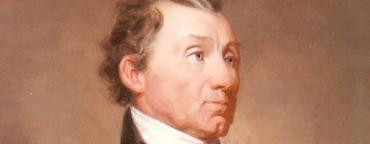
Florida has always been something of an afterthought in the American Revolution. Despite American efforts in the early stages of the war, the two colonies of East Florida and West Florida remained in British hands, though the Spanish broke through in Pensacola in 1781. Few of the Founding Fathers got involved with Florida though three South Carolinians who had signed the Declaration of Independence -- Arthur Middleton, Edward Rutledge and Thomas Heyward -- would be imprisoned in St. Augustine after the fall of Charleston.
Fittingly enough, the Founding Father who most shaped Florida is also something of an afterthought. James Monroe simply wasn’t as heroic as George Washington, as fiery as Sam Adams or Patrick Henry, as stubborn as John Adams, as intelligent as Alexander Hamilton and James Madison and, unlike Benjamin Franklin and his friend Thomas Jefferson, wasn't a personification of the Enlightenment.
The last member of the Virginia Dynasty, the three presidents from the Old Dominion who presided over the White House from 1801 until 1825, Monroe did not have the original and creative mind that his predecessors and friends, Jefferson and Madison, possessed. As historian George Dangerfield noted in his Pulitzer Prize-winning "The Era of Good Feelings," even in studies of the Monroe administration, it’s easy to lose focus on the president himself.
But Monroe’s fingerprints are all over American history and he pops up in the strangest places, from helping Lafayette out during the French Revolution to playing a major role in the Louisiana Purchase to ensuring Amelia Island would be the first part of Florida in the United States. Next time you look at Emanuel Gottlieb Leutze’s “Washington Crossing the Delaware” take note of the young soldier carrying the American flag. That’s Monroe who would be wounded at the Battle of Trenton after the crossing.
Historians peg Dwight Eisenhower as the hidden handed president whose influence was often behind the scenes. The description probably fits Monroe better, especially his activities with Florida. In 1817, Monroe’s administration gave a wink and a nod to Scottish adventurer and con man extraordinaire Gregor MacGregor’s attempts to create an independent republic in Florida. Six months after MacGregor raised the Green Cross Flag and declared freedom from Spain, Amelia Island was handed over to the Americans. While Monroe’s defenders (Harry Ammon in particular in his magisterial biography of our fifth president) still insist that Andrew Jackson had no authorization to send American troops into Spanish Florida in 1818, increasingly the consensus is that the president backed the invasion. Dangerfield noted that whoever possessed the Floridas held a pistol at the heart of the republic -- something Monroe knew quite well after the near-disasters in the War of 1812 -- and so he gave Jackson the green light. In 1819, John Quincy Adams, Monroe’s secretary of state, concluded negotiations with Spain and the Adams-Onis treaty ensured Florida would be an American territory.
Even though his presidency is generally considered a success, Monroe takes a back seat in the history books as the second generation of American political leaders -- Quincy Adams, Jackson, John C. Calhoun, Henry Clay, William H. Crawford, John Randolph and other colorful political leaders -- take the stage.
As a senior at Trinity College, I wrote a thesis on Calhoun’s tenure as secretary of war under Monroe -- and, yes, I lost sight of Monroe. I wrote the thesis planning to scorch Jackson for disobeying orders and invading Florida without the authorization of either Monroe or Calhoun. To my chagrin, I concluded Monroe and, to a lesser extent Calhoun, was a very late appointment into the Cabinet, and offered subtle signs backing the operation.
So under President Monroe, the American government invaded and eventually bought Florida from Spain. The Sunshine State seems to have honored him more than other states. There is a county named after Monroe and it's fitting that the Capitol in Tallahassee is on a street named after him.
Near-bankrupt when he left the White House, Monroe would move to New York to live with his daughter. He passed away on July 4, 1831 -- five years to the day after both Jefferson and John Adams died, on Independence Day. Even in his death, Monroe seemed to be an afterthought among the Founding Fathers -- but he is the one member of that remarkable generation of political leaders whose fingerprints are all over the Sunshine State.
Reach Kevin Derby at kderby@sunshinestatenews.com or follow him on Twitter: @KevinDerbySSN


